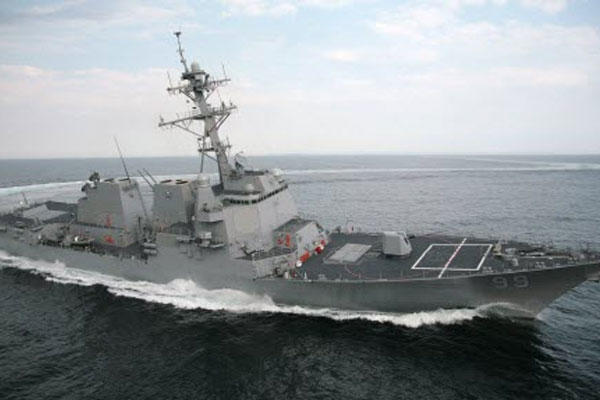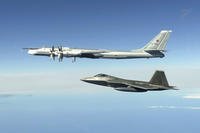The U.S. Navy sent the guided-missile destroyer Farragut at "best speed" into the Straits of Hormuz yesterday after Iranian Revolutionary Guards patrol craft fired warning shots and boarded a Marshall Islands-flagged container ship.
The U.S. Navy also put up an unarmed maritime patrol aircraft to monitor the 837-foot, 65,000-ton MV Maersk Tigris, which was forced to proceed towards Iran's Larak Island in the heavily-travelled Straits, the chokepoint for much of the world's oil traffic between the Persian Gulf and the Arabian Sea.
Pentagon spokesman Col. Steve Warren said that there were no Americans among the Maersk Tigris crew of about 30, and there were no immediate reports that any had been injured.
The Danish-owned Maersk Tigris, which was registered in the Marshall Islands, was proceeding north through the narrow shipping channel of the 21-mile wide Straits when several armed speedboats from the Iranian Revolutionary Guard Corps Navy began circling.
"The master was contacted and directed to proceed further into Iranian territorial waters," Warren said. "He declined and one of the IRGCN craft fired shots across the bridge of the Maersk Tigris."
Following the warning shots, "the master complied with the Iranian demand and proceeded into Iranian waters in the vicinity of Larak Island" but not before putting out a distress call that was picked up by the Navy at the U.S. Central Command, Warren said.
The incident began at about 4:05 a.m. EDT Tuesday when the Iranian speedboats approached the Maersk Tigris. The 509-foot, Arleigh Burke class Farragut was dispatched to the Straits after the shots were fired and was remaining in international waters, Warren said.
Iran's Fars news agency said that "the vessel had been seized for trespassing on Iran's territorial waters in the Persian Gulf." Another Iranian news agency, Tasnim, reported that the incident did not have a "military or political dimension and is a civil matter."
Both Warren and State Department spokesman Jeff Rathke said that the U.S. had security obligations to the Marshall Islands, which included coming to the defense of Marshall Islands-flagged ships.
Marshall Islands officials have yet to ask for military assistance "but we do have a security compact," Rathke said.
The Marshall Islands, scene of bloody island-hopping battles at Kwajelien and Eniwetok in World War II, were administered by the U.S. after the war. They attained full independence in 1986 under a Compact of Free Association with the U.S. which included U.S. defense guarantees.
Rathke said Iran had yet to give the U.S. a reason for the action against the Maersk Tigris and "I'm not going to speculate on what their motives might be." When asked if the Revolutionary Guards might be sending a message against the nuclear talks with the U.S., Rathke said "it's premature to jump to that conclusion."
It was unclear whether the Maersk Tigris may have strayed into Iranian territorial waters. The Straits have a northbound, two-mile wide shipping lane and a two-mile wide southbound shipping lane, with a two-mile buffer zone in between.
"Almost any scenario is plausible" in trying to discern the reasons for the actions of the Revolutionary Guards, said Chris Harmer, the former deputy director of future operations for the Navy's Fifth Fleet based in Manama, Bahrain.
The move against the Maersk Tigris could be seen as payback for the U.S. dispatch of the aircraft carrier Teddy Roosevelt to the Gulf of Aden last week to monitor an Iranian convoy suspected of carrying arms for the Houthi rebels in Yemen, said Harmer, an analyst at the Institute for the Study of War.
The convoy of nine cargo ships and two Iranian Navy warships was proceeding back to the Persian Gulf Tuesday and was reported heading north at the entrance to the Straits of Hormuz.
Firing on the container ship could also be the action of an Iranian "deviationist group that wants to scuttle the deal" between the U.S. and Iran to rein in Iran's nuclear programs in return for easing economic sanctions, Harmer said.
Another possible scenario involved the enmity of the leader of the Revolutionary Guards, Maj. Gen. Mohammed Ali Jafari, towards Saudi Arabia for conducting airstrikes in Yemen against the Houthis, Harmer said.
The Maersk Tigris was proceeding from the Saudi port at Jeddah to the United Arab Emirates port of Jebel Ali. "Hard as it might be for us to comprehend, maybe they (the Revolutionary Guards) said we're just going to do this to yank the Saudis chain."
-- Richard Sisk can be reached at richard.sisk@military.com






























